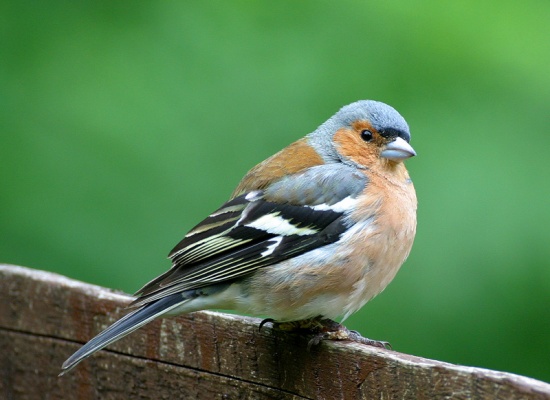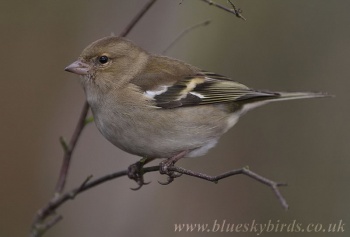(C/right. Amended user template) |
(Picture of posturing males. References updated) |
||
| Line 2: | Line 2: | ||
;[[:Category:Fringilla|Fringilla]] coelebs | ;[[:Category:Fringilla|Fringilla]] coelebs | ||
==Identification== | ==Identification== | ||
| + | [[Image:chaffinch_female.jpg|thumb|350px|right|Female of subspecies ''F. c. gengleri''<br />Photo © by {{user|postcardcv|postcardcv}}<br /> RSPB [[Ynys-hir]], [[Wales]], July 2004]] | ||
Length 14-18 cm (5½-7 in), weight 17-29 g<br/> | Length 14-18 cm (5½-7 in), weight 17-29 g<br/> | ||
*Large double white wing bars and below the lower an extra white spot. | *Large double white wing bars and below the lower an extra white spot. | ||
*White tail edges | *White tail edges | ||
*Greenish rump | *Greenish rump | ||
| − | *'''Breeding male''': Reddish-pink underparts and grey cap. | + | *'''Breeding male''': |
| − | *'''Winter male''': Colours slightly duller, with wingbars often tinged yellow-buff. | + | Reddish-pink underparts and grey cap. |
| − | *'''Female''': Drabber and greener, but still obvious. | + | *'''Winter male''': |
| − | *'''Immature''': As female, but with wingbars even duller yellow-buff. | + | Colours slightly duller, with wingbars often tinged yellow-buff. |
| − | + | *'''Female''': | |
| − | Variation | + | Drabber and greener, but still obvious. |
| + | *'''Immature''': | ||
| + | As female, but with wingbars even duller yellow-buff. | ||
| + | |||
| + | ====Variation==== | ||
| + | Males in north [[Africa]] and The [[Canaries]] look quite different, more blue/green and less red colours showing. See also ref<sup>[[#References|[1]]]</sup> | ||
====Similar species==== | ====Similar species==== | ||
| + | [[Image:Chaffinch-_form-africana_by_sdaly.jpg|thumb|350px|right|Male of subspecies ''F. c. africana''<br />Photo © by {{user|sdaly|sdaly}}<br />Middle Atlas, [[Morocco]], November 2005]] | ||
[[Brambling]] is often found together with Chaffinches in winter; it differs in an orange (not pink) breast and wingbars, whiter belly, dark spots on the flanks, white rump, and lacking the white sides to the tail. | [[Brambling]] is often found together with Chaffinches in winter; it differs in an orange (not pink) breast and wingbars, whiter belly, dark spots on the flanks, white rump, and lacking the white sides to the tail. | ||
==Distribution== | ==Distribution== | ||
| Line 23: | Line 30: | ||
Introduced in [[New Zealand]] and the Cape Town area of [[South Africa]]. | Introduced in [[New Zealand]] and the Cape Town area of [[South Africa]]. | ||
==Taxonomy== | ==Taxonomy== | ||
| − | [[Image: | + | [[Image:Chaffinch_from_La_Gomera_by_acrocephalus00.JPG|thumb|350px|right|Male of subspecies ''F. c. canariensis''<br />Photo © by {{user|acrocephalus00|acrocephalus00}}<br />La Gomera, [[Canary Islands]].]] |
====Subspecies==== | ====Subspecies==== | ||
| − | [[Image: | + | [[Image:IMG 0538as.jpg|thumb|350px|right|Male in flight<br />Photo © by the late '''[http://www.birdforum.net/gallery/showgallery.php/ppuser/67980/cat/500 Rookery]'''<br />Te Awanga, Hawke's Bay, [[New Zealand]], July 2011]] |
There are 16 subspecies<sup>[[#References|[2]]]</sup> which can be grouped into three main groups: European (including southwest Asia), north African, and the forms on the Atlantic islands. Some authors have suggested some of these subspecies may deserve status as full species, but this is not supported by genetic data<sup>[[#References|[3]]]</sup>. | There are 16 subspecies<sup>[[#References|[2]]]</sup> which can be grouped into three main groups: European (including southwest Asia), north African, and the forms on the Atlantic islands. Some authors have suggested some of these subspecies may deserve status as full species, but this is not supported by genetic data<sup>[[#References|[3]]]</sup>. | ||
*European & SW Asian subspecies: | *European & SW Asian subspecies: | ||
| Line 47: | Line 54: | ||
**''F. c. palmae'': La Palma ([[Canary Islands]]); resident | **''F. c. palmae'': La Palma ([[Canary Islands]]); resident | ||
==Habitat== | ==Habitat== | ||
| − | [[Image: | + | [[Image:1408 Finch African Chaffinch a07.jpg|thumb|350px|right|Posturing males; subspecies ''africana'' on left, probably nominate subspecies on right<br />Photo © by {{user|peterday|peterday}}<br />Khemisset, [[Morocco]], March 2018]] |
Woods, hedges, parks and gardens. | Woods, hedges, parks and gardens. | ||
==Behaviour== | ==Behaviour== | ||
| Line 62: | Line 69: | ||
==References== | ==References== | ||
#[http://www.birdforum.net/showthread.php?t=160979 Thread] in the BF id forum discussing aberrant bluish Chaffinch. | #[http://www.birdforum.net/showthread.php?t=160979 Thread] in the BF id forum discussing aberrant bluish Chaffinch. | ||
| − | #{{Ref- | + | #{{Ref-Clements6thAug18}}#Collinson, M. (2001). Evolution of the Atlantic-island Chaffinches. ''Brit. Birds'' 94 (3): 121–124. |
#Bird Watching | #Bird Watching | ||
#[http://www.birdforum.net/showthread.php?p=3002500 Birdforum thread] with taxonomy info. In post 6 there is info on separating African from European versions | #[http://www.birdforum.net/showthread.php?p=3002500 Birdforum thread] with taxonomy info. In post 6 there is info on separating African from European versions | ||
Revision as of 23:25, 13 December 2018
- Fringilla coelebs
Identification
Length 14-18 cm (5½-7 in), weight 17-29 g
- Large double white wing bars and below the lower an extra white spot.
- White tail edges
- Greenish rump
- Breeding male:
Reddish-pink underparts and grey cap.
- Winter male:
Colours slightly duller, with wingbars often tinged yellow-buff.
- Female:
Drabber and greener, but still obvious.
- Immature:
As female, but with wingbars even duller yellow-buff.
Variation
Males in north Africa and The Canaries look quite different, more blue/green and less red colours showing. See also ref[1]
Similar species
Brambling is often found together with Chaffinches in winter; it differs in an orange (not pink) breast and wingbars, whiter belly, dark spots on the flanks, white rump, and lacking the white sides to the tail.
Distribution
Widespread and very familiar throughout Europe. It is the most common finch in most of western and northern Europe. Its range extends into western Asia, north-western Africa, the Canary Islands and Madeira.
It is also found on Tenerife and Gran Canaria, along with the related endemic Blue Chaffinch.
Summer visitor in northern and eastern Europe, found all year in the rest of Europe.
Introduced in New Zealand and the Cape Town area of South Africa.
Taxonomy
Subspecies
There are 16 subspecies[2] which can be grouped into three main groups: European (including southwest Asia), north African, and the forms on the Atlantic islands. Some authors have suggested some of these subspecies may deserve status as full species, but this is not supported by genetic data[3].
- European & SW Asian subspecies:
- F. c. coelebs: continental Europe to western Siberia and Asia Minor; resident or migratory, winters south to Africa and Nepal
- F. c. gengleri: British Isles, Orkneys and Outer Hebrides; resident
- F. c. balearica: Iberian Peninsula and Balearic Islands; resident
- F. c. sarda: Sardinia; resident
- F. c. schiebeli: Crete; resident
- F. c. syriaca: Cyprus and Levant; resident
- F. c. solomkoi: Crimean Peninsula and Caucasus; resident
- F. c. alexandrovi: northern Iran; resident
- F. c. transcaspica: northeastern Iran (Kopet Dagh and Khorasan); resident
- North African subspecies:
- Atlantic islands subspecies:
- F. c. moreletti: Azores; resident
- F. c. maderensis: Madeira; resident
- F. c. canariensis: Canary Islands (Gran Canaria, Gomera and Tenerife); resident
- F. c. ombriosa: Hierro (Canary Islands); resident
- F. c. palmae: La Palma (Canary Islands); resident
Habitat
Woods, hedges, parks and gardens.
Behaviour
Breeding
It builds a neat cup of grass lichen or moss. The clutch consists of 4-5 light blue eggs, with purply-brown spots. Incubation takes 12-13 days with a further 13-16 days to fledging. There is 1 brood in the season which lasts from April to the end of June.
Diet
The diet includes insects in breeding season and mainly seeds at other times.
Vocalisation
Song: A series of Chip-Chip-Chip notes
Call: A loud Pink Pink
<flashmp3>Fringilla coelebs (song).mp3</flashmp3>
Listen in an external program
References
- Thread in the BF id forum discussing aberrant bluish Chaffinch.
- Clements, J. F., T. S. Schulenberg, M. J. Iliff, D. Roberson, T. A. Fredericks, B. L. Sullivan, and C. L. Wood. 2018. The eBird/Clements checklist of birds of the world: v2018. Downloaded from http://www.birds.cornell.edu/clementschecklist/download/
- Collinson, M. (2001). Evolution of the Atlantic-island Chaffinches. Brit. Birds 94 (3): 121–124.
- Bird Watching
- Birdforum thread with taxonomy info. In post 6 there is info on separating African from European versions
Recommended Citation
- BirdForum Opus contributors. (2024) Common Chaffinch. In: BirdForum, the forum for wild birds and birding. Retrieved 11 May 2024 from https://www.birdforum.net/opus/Common_Chaffinch
External Links









